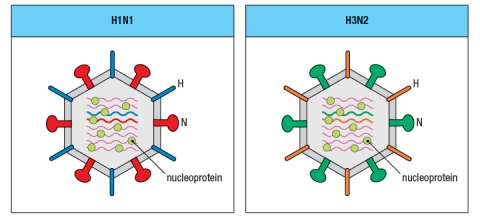Synthesis question: For the last five years, the seasonal flu vaccine has contained a mixture of two Influenza A strains and one Influenza B strain. The Influenza A strains were categorized as H1N1 and H3N2 subtypes. This nomenclature refers to the sequences of the two surface glycoproteins on the Influenza A virus particle, the hemaglutinin (H) and the neuraminidase (N). Antibodies specific for these glycoproteins are known to be effective at preventing flu infection. 
a) The highly pathogenic Asian avian flu causes a fatal infection in about 60% of the individuals infected. The seasonal flu vaccine does not provide protection against this strain of Influenza. Is the highly pathogenic Asian avian flu likely to be an H1N1 or H3N2 strain of influenza? Why or why not?
In the seasonal vaccine, the two strains of Influenza A, H1N1 and H3N2, are both required to provide protection to individuals exposed to one or the other of the viral strains. Currently, research efforts are focused on trying to generate protective CD8 T cell responses to Influenza A, with the goal of generating a 'universal' or broadly neutralizing vaccine that would provide protection against multiple strains of the virus, even those not included in the vaccine.
b) Based on the information provided in the cartoon of the two viral strains shown in Figure , what is the reasoning for expecting CD8 T cell responses to be protective against multiple different strains of Influenza A?
From year to year, the Influenza A strains circulating in the population undergo a process known as 'antigenic drift' in which mutations accumulate in the viral genes, leading to modest changes in the amino acid sequences of the viral proteins. Due to this antigenic drift, different isolates of the H1N1 or H3N2 strains are included in the annual flu vaccine. Shown in Figure are some of the regions of viral proteins that often undergo antigenic drift from year to year. 
c) What is the minimum number of amino acids that needs to change for a neutralizing antibody to the neuraminidase of the H1N1 strain on the left to no longer bind to the neuraminidase of the H1N1 strain on the right?
Definitions:
Superordinate Goals
Goals shared and valued by individuals or groups working together, which guide cooperative efforts towards problem-solving or achieving a common objective.
Formal Rules
Explicitly stated regulations or guidelines that govern behavior and operations within an organization or society.
Context Factor
A variable or condition that impacts the environment or outcomes within a specific situation.
Team Goals
Objectives or outcomes that a group collectively aims to achieve, usually within a set timeframe, as a part of collaborative efforts.
Q16: Peptide editing is an important component of
Q21: In some cases, antibody binding to a
Q29: Important information can be learned by studying
Q31: TNF-receptor signaling commonly includes several steps
Q36: Vaccination against many infectious diseases has provided
Q37: The 2009 CPI was 214.537 (1982-84 =
Q44: One surprising aspect of the immune system
Q84: To analyze data cross-classified in a
Q89: i. Etienne Laspeyres developed a method in
Q115: A school is trying to determine if